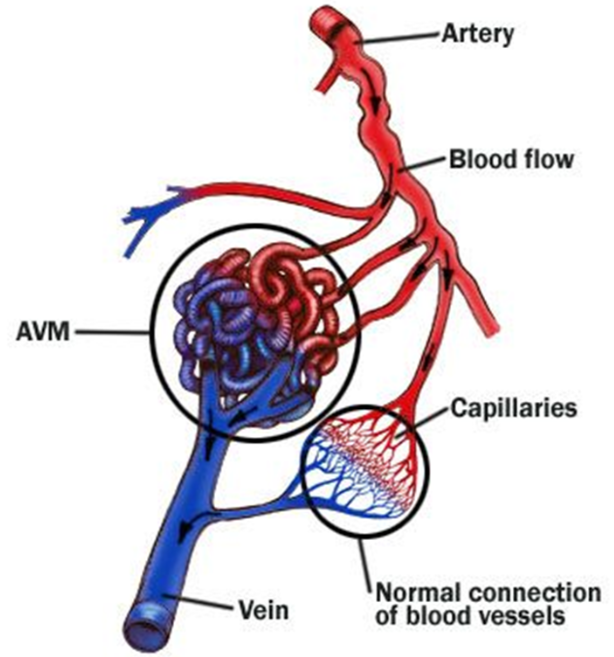Arteriovenous Malformation (AVM)
Comprehensive Stroke Center
What is a brain AVM?
The arteries in your body carry blood with oxygen from your heart to your brain. Your veins carry blood with less oxygen away from your brain and back to your heart.
A brain AVM hinders this vital process. An AVM is a tangle of blood vessels in your brain that connect your arteries and veins.
Most AVMs don’t grow or change much. The blood vessels involved may widen.
Brain AVMs are rare. It affects less than 1 percent of people. AVMs are more common in males than in females.
|
 |
Why do brain AVMs occur?
In most cases, people are born with a brain AVM. People usually don’t inherit an AVM from their parents, and won’t pass one on to their children.
What are the symptoms of a brain AVM?
Your symptoms may vary. It depends on where the AVM is located. You may not have symptoms until the AVM ruptures. This causes bleeding in your brain called a hemorrhage. In half of all brain AVMs this is the first sign. Other symptoms may include:
- Seizures
- Headaches
- Muscle weakness
- Pain in one area of your head
- Hard time with your speech or vision
What causes brain AVMs to bleed?
A brain AVM contains weakened blood vessels that direct blood away from normal brain tissue. These abnormal and weak blood vessels widen over time. At some point, they may burst from the high pressure of blood flow from the arteries.
The risk of bleeding again in your brain is slightly higher for a short time after the first bleed. People who are between 11 to 35 years old and who have an AVM are at a slightly higher risk of bleeding.
The risk of death from each bleed is about 1 in 10. The chance of permanent brain damage is about 3 in 10.
Each time blood leaks into the brain, normal brain tissue is damaged. This results in loss of normal function, which may be temporary or permanent.
Types of brain AVMs
True arteriovenous malformation (AVM): This is the most common brain vascular malformation. It’s a tangle of abnormal vessels that connect arteries and veins.
Occult or cryptic AVM or cavernous malformations: This is a vascular malformation in the brain that doesn’t actively divert large amounts of blood. It may bleed and often causes seizures.
Venous malformation: This is a defect only of the veins.
Hemangioma: These are abnormal blood vessel structures. Most times it’s on the surface of the brain and skin or facial structures.
Diagnoses
A CT or MRI brain scan can spot most AVMs. We may need to do an angiogram to clearly identify the type of AVM for treatment. You may have treatment for an AVM if it’s:
- Bleeding
- Not too large
- In an area of the brain that can be easily treated
Treatments depend on:
- What type of AMV it is.
- Symptoms it may be causing.
- The location and size.
Treatments for AVMs
Medical therapy: You may need a more conservative treatment plan if:
- There are no symptoms or almost none.
- An AVM is in an area of the brain that can’t be easily treated.
These patients are told to stay away from blood thinners such as warfarin. Try also not to do extreme exercise.
Surgery: Your health care team may recommend surgery if the AVM has bled. It also needs to be in a reachable area.
Stereotactic radiosurgery: Your health care team may treat an AVM with stereotactic radiosurgery that’s not too large. But in an area that’s hard to reach by regular surgery. In this procedure, a cerebral angiogram is done to pinpoint the AVM. Your surgeon uses focused-beam high energy sources on the AVM. This causes a scar and allows the AVM to clot off.
Interventional neuroradiology or endovascular neurosurgery: Your health care team places a small tube called a catheter inside your blood vessels. It blocks off the abnormal vessels with glue or coils. It may be possible to treat part or all of the AVM with this treatment plan.
Image source: ECR 2019 / C-2665